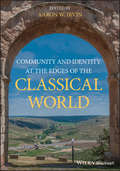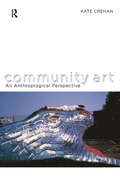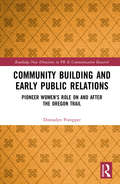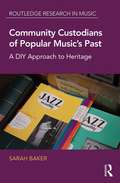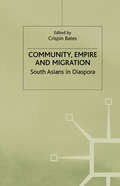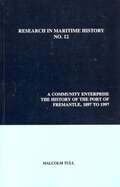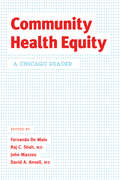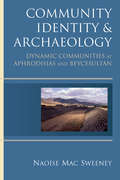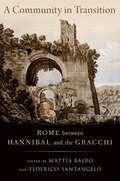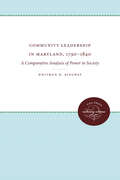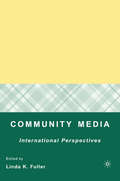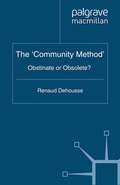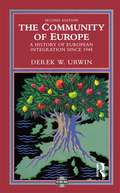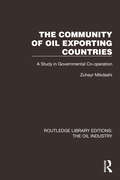- Table View
- List View
Community and Identity at the Edges of the Classical World
by Aaron W. IrvinA timely and academically-significant contribution to scholarship on community, identity, and globalization in the Roman and Hellenistic worlds Community and Identity at the Edges of the Classical World examines the construction of personal and communal identities in the ancient world, exploring how globalism, multi-culturalism, and other macro events influenced micro identities throughout the Hellenistic and Roman empires. This innovative volume discusses where contact and the sharing of ideas was occurring in the time period, and applies modern theories based on networks and communication to historical and archaeological data. A new generation of international scholars challenge traditional views of Classical history and offer original perspectives on the impact globalizing trends had on localized areas—insights that resonate with similar issues today. This singular resource presents a broad, multi-national view rarely found in western collected volumes, including Serbian, Macedonian, and Russian scholarship on the Roman Empire, as well as on Roman and Hellenistic archaeological sites in Eastern Europe. Topics include Egyptian identity in the Hellenistic world, cultural identity in Roman Greece, Romanization in Slovenia, Balkan Latin, the provincial organization of cults in Roman Britain, and Soviet studies of Roman Empire and imperialism. Serving as a synthesis of contemporary scholarship on the wider topic of identity and community, this volume: Provides an expansive materialist approach to the topic of globalization in the Roman world Examines ethnicity in the Roman empire from the viewpoint of minority populations Offers several views of metascholarship, a growing sub-discipline that compares ancient material to modern scholarship Covers a range of themes, time periods, and geographic areas not included in most western publications Community and Identity at the Edges of the Classical World is a valuable resource for academics, researchers, and graduate students examining identity and ethnicity in the ancient world, as well as for those working in multiple fields of study, from Classical, Hellenistic, and Roman historians, to the study of ethnicity, identity, and globalizing trends in time.
Community Art: An Anthropological Perspective
by Kate CrehanExploring key issues for the anthropology of art and art theory, this fascinating text provides the first in-depth study of community art from an anthropological perspective.The book focuses on the forty year history of Free Form Arts Trust, an arts group that played a major part in the 1970s struggle to carve out a space for community arts in Britain. Turning their back on the world of gallery art, the fine-artist founders of Free Form were determined to use their visual expertise to connect, through collaborative art projects, with the working-class people excluded by the established art world. In seeking to give the residents of poor communities a greater role in shaping their built environment, the artists' aesthetic practice would be transformed.Community Art examines this process of aesthetic transformation and its rejection of the individualized practice of the gallery artist. The Free Form story calls into question common understandings of the categories of "art," "expertise," and "community," and makes this story relevant beyond late twentieth-century and early twenty-first-century Britain.
Community Art: An Anthropological Perspective
by Kate CrehanExploring key issues for the anthropology of art and art theory, this fascinating text provides the first in-depth study of community art from an anthropological perspective.The book focuses on the forty year history of Free Form Arts Trust, an arts group that played a major part in the 1970s struggle to carve out a space for community arts in Britain. Turning their back on the world of gallery art, the fine-artist founders of Free Form were determined to use their visual expertise to connect, through collaborative art projects, with the working-class people excluded by the established art world. In seeking to give the residents of poor communities a greater role in shaping their built environment, the artists' aesthetic practice would be transformed.Community Art examines this process of aesthetic transformation and its rejection of the individualized practice of the gallery artist. The Free Form story calls into question common understandings of the categories of "art," "expertise," and "community," and makes this story relevant beyond late twentieth-century and early twenty-first-century Britain.
Community Building and Early Public Relations: Pioneer Women’s Role on and after the Oregon Trail (Routledge New Directions in PR & Communication Research)
by Donnalyn PompperFrom the start, women were central to a century of westward migration in the U.S. Community Building and Early Public Relations: Pioneer Women’s Role on and after the Oregon Trail offers a path forward in broadening PR's Caucasian/White male-gendered history in the U.S. Undergirded by humanist, communitarian, critical race theory, social constructionist perspectives, and a feminist communicology lens, this book analyzes U.S. pioneer women's lived experiences, drawing parallels with PR's most basic functions – relationship-building, networking, community building, boundary spanning, and advocacy. Using narrative analysis of diaries and reminiscences of women who travelled 2,000+ miles on the Oregon Trail in the mid-to-late 1800s, Pompper uncovers how these women filled roles of Caretaker/Advocate, Community Builder of Meeting Houses and Schools, served a Civilizing Function, offered Agency and Leadership, and provided Emotional Connection for Social Cohesion. Revealed also is an inevitable paradox as Caucasian/White pioneer women’s interactional qualities made them complicit as colonizers, forever altering indigenous peoples’ way of life. This book will be of interest to undergraduate and graduate PR students, PR practitioners, and researchers of PR history and social identity intersectionalities. It encourages us to expand the definition of PR to include community building, and to revise linear timeline and evolutionary models to accommodate voices of women and people of color prior to the twentieth century.
Community Building and Early Public Relations: Pioneer Women’s Role on and after the Oregon Trail (Routledge New Directions in PR & Communication Research)
by Donnalyn PompperFrom the start, women were central to a century of westward migration in the U.S. Community Building and Early Public Relations: Pioneer Women’s Role on and after the Oregon Trail offers a path forward in broadening PR's Caucasian/White male-gendered history in the U.S. Undergirded by humanist, communitarian, critical race theory, social constructionist perspectives, and a feminist communicology lens, this book analyzes U.S. pioneer women's lived experiences, drawing parallels with PR's most basic functions – relationship-building, networking, community building, boundary spanning, and advocacy. Using narrative analysis of diaries and reminiscences of women who travelled 2,000+ miles on the Oregon Trail in the mid-to-late 1800s, Pompper uncovers how these women filled roles of Caretaker/Advocate, Community Builder of Meeting Houses and Schools, served a Civilizing Function, offered Agency and Leadership, and provided Emotional Connection for Social Cohesion. Revealed also is an inevitable paradox as Caucasian/White pioneer women’s interactional qualities made them complicit as colonizers, forever altering indigenous peoples’ way of life. This book will be of interest to undergraduate and graduate PR students, PR practitioners, and researchers of PR history and social identity intersectionalities. It encourages us to expand the definition of PR to include community building, and to revise linear timeline and evolutionary models to accommodate voices of women and people of color prior to the twentieth century.
Community Custodians of Popular Music's Past: A DIY Approach to Heritage (Routledge Research in Music)
by Sarah BakerThis book examines do-it-yourself (DIY) approaches to the collection, preservation, and display of popular music heritage being undertaken by volunteers in community archives, museums and halls of fame globally. DIY institutions of popular music heritage are much more than ‘unofficial’ versions of ‘official’ institutions; rather, they invoke a complex network of affect and sociality, and are sites where interested people – often enthusiasts – are able to assemble around shared goals related to the preservation of and ownership over the material histories of popular music culture. Drawing on interviews and observations with founders, volunteers and heritage workers in 23 DIY institutions in Australasia, Europe and North America, the book highlights the potentialities of bottom-up, community-based interventions into the archiving and preservation of popular music’s material history. It reveals the kinds of collections being housed in these archives, how they are managed and maintained, and explores their relationship to mainstream heritage institutions. The study also considers the cultural labor of volunteers in the DIY institution, arguing that while these are places concerned with heritage management and the preservation of artefacts, they are also extensions of musical communities in the present in which activities around popular music preservation have personal, cultural, community and heritage benefits. By looking at volunteers’ everyday interventions in the archiving and curating of popular music’s material past, the book highlights how DIY institutions build upon national heritage strategies at the community level and have the capacity to contribute to the democratization of popular music heritage. This book will have a broad appeal to a range of scholars in the fields of popular music studies, musicology, ethnomusicology, archive studies and archival science, museum studies, critical heritage studies, cultural studies, cultural sociology and media studies.
Community Custodians of Popular Music's Past: A DIY Approach to Heritage (Routledge Research in Music)
by Sarah BakerThis book examines do-it-yourself (DIY) approaches to the collection, preservation, and display of popular music heritage being undertaken by volunteers in community archives, museums and halls of fame globally. DIY institutions of popular music heritage are much more than ‘unofficial’ versions of ‘official’ institutions; rather, they invoke a complex network of affect and sociality, and are sites where interested people – often enthusiasts – are able to assemble around shared goals related to the preservation of and ownership over the material histories of popular music culture. Drawing on interviews and observations with founders, volunteers and heritage workers in 23 DIY institutions in Australasia, Europe and North America, the book highlights the potentialities of bottom-up, community-based interventions into the archiving and preservation of popular music’s material history. It reveals the kinds of collections being housed in these archives, how they are managed and maintained, and explores their relationship to mainstream heritage institutions. The study also considers the cultural labor of volunteers in the DIY institution, arguing that while these are places concerned with heritage management and the preservation of artefacts, they are also extensions of musical communities in the present in which activities around popular music preservation have personal, cultural, community and heritage benefits. By looking at volunteers’ everyday interventions in the archiving and curating of popular music’s material past, the book highlights how DIY institutions build upon national heritage strategies at the community level and have the capacity to contribute to the democratization of popular music heritage. This book will have a broad appeal to a range of scholars in the fields of popular music studies, musicology, ethnomusicology, archive studies and archival science, museum studies, critical heritage studies, cultural studies, cultural sociology and media studies.
Community, Empire and Migration: South Asians in Diaspora
by Crispin BatesSouth Asians in Diaspora is a collection of essays concerning the history, politics, and anthropology of migration in India, Pakistan, and Sri Lanka, as well as in the numerous overseas locations, such as Fiji, Africa, the Caribbean and USA, where South Asians migrated in the colonial period and after. It addresses the connections between migration, problems of identity and ethnic conflict from a comparative perspective, and highlights the role of shared colonial experiences in providing 'communal' solidarities and discord.
A Community Enterprise: The History of the Port of Fremantle, 1897 to 1997 (Research in Maritime History #12)
by Malcolm TullThis volume concerns the history of the Australian port of Fremantle, located on the edge of Western Australia and the Indian Ocean, throughout the hundred years of frequent changes to its structure and function between 1897 and 1997. Tull’s aim is to use Fremantle as a prime example of the complex network of a Port, as a community and a place of vast and varied maritime business endeavours. He seeks to erase the perception of ports as ‘passive links in the international transport chain’ in order to draw ports to the attention and further research of maritime historians. The chapters are arranged thematically rather than chronologically, and includes statistical appendices, a bibliography, and an index, for ease of navigation.
Community Health Equity: A Chicago Reader
by David A. AnsellPerhaps more than any other American city, Chicago has been a center for the study of both urban history and economic inequity. Community Health Equity assembles a century of research to show the range of effects that Chicago’s structural socioeconomic inequalities have had on patients and medical facilities alike. The work collected here makes clear that when a city is sharply divided by power, wealth, and race, the citizens who most need high-quality health care and social services have the greatest difficulty accessing them. Achieving good health is not simply a matter of making the right choices as an individual, the research demonstrates: it’s the product of large-scale political and economic forces. Understanding these forces, and what we can do to correct them, should be critical not only to doctors but to sociologists and students of the urban environment—and no city offers more inspiring examples for action to overcome social injustice in health than Chicago.
Community Health Equity: A Chicago Reader
by David A. AnsellPerhaps more than any other American city, Chicago has been a center for the study of both urban history and economic inequity. Community Health Equity assembles a century of research to show the range of effects that Chicago’s structural socioeconomic inequalities have had on patients and medical facilities alike. The work collected here makes clear that when a city is sharply divided by power, wealth, and race, the citizens who most need high-quality health care and social services have the greatest difficulty accessing them. Achieving good health is not simply a matter of making the right choices as an individual, the research demonstrates: it’s the product of large-scale political and economic forces. Understanding these forces, and what we can do to correct them, should be critical not only to doctors but to sociologists and students of the urban environment—and no city offers more inspiring examples for action to overcome social injustice in health than Chicago.
Community Health Equity: A Chicago Reader
by David A. AnsellPerhaps more than any other American city, Chicago has been a center for the study of both urban history and economic inequity. Community Health Equity assembles a century of research to show the range of effects that Chicago’s structural socioeconomic inequalities have had on patients and medical facilities alike. The work collected here makes clear that when a city is sharply divided by power, wealth, and race, the citizens who most need high-quality health care and social services have the greatest difficulty accessing them. Achieving good health is not simply a matter of making the right choices as an individual, the research demonstrates: it’s the product of large-scale political and economic forces. Understanding these forces, and what we can do to correct them, should be critical not only to doctors but to sociologists and students of the urban environment—and no city offers more inspiring examples for action to overcome social injustice in health than Chicago.
Community Health Equity: A Chicago Reader
by Fernando De Maio David A. Ansell John Mazzeo Raj C. ShahPerhaps more than any other American city, Chicago has been a center for the study of both urban history and economic inequity. Community Health Equity assembles a century of research to show the range of effects that Chicago’s structural socioeconomic inequalities have had on patients and medical facilities alike. The work collected here makes clear that when a city is sharply divided by power, wealth, and race, the citizens who most need high-quality health care and social services have the greatest difficulty accessing them. Achieving good health is not simply a matter of making the right choices as an individual, the research demonstrates: it’s the product of large-scale political and economic forces. Understanding these forces, and what we can do to correct them, should be critical not only to doctors but to sociologists and students of the urban environment—and no city offers more inspiring examples for action to overcome social injustice in health than Chicago.
Community Health Equity: A Chicago Reader
by Fernando De Maio David Ansell John Mazzeo Raj ShahPerhaps more than any other American city, Chicago has been a center for the study of both urban history and economic inequity. Community Health Equity assembles a century of research to show the range of effects that Chicago’s structural socioeconomic inequalities have had on patients and medical facilities alike. The work collected here makes clear that when a city is sharply divided by power, wealth, and race, the citizens who most need high-quality health care and social services have the greatest difficulty accessing them. Achieving good health is not simply a matter of making the right choices as an individual, the research demonstrates: it’s the product of large-scale political and economic forces. Understanding these forces, and what we can do to correct them, should be critical not only to doctors but to sociologists and students of the urban environment—and no city offers more inspiring examples for action to overcome social injustice in health than Chicago.
Community Health Equity: A Chicago Reader
Perhaps more than any other American city, Chicago has been a center for the study of both urban history and economic inequity. Community Health Equity assembles a century of research to show the range of effects that Chicago’s structural socioeconomic inequalities have had on patients and medical facilities alike. The work collected here makes clear that when a city is sharply divided by power, wealth, and race, the citizens who most need high-quality health care and social services have the greatest difficulty accessing them. Achieving good health is not simply a matter of making the right choices as an individual, the research demonstrates: it’s the product of large-scale political and economic forces. Understanding these forces, and what we can do to correct them, should be critical not only to doctors but to sociologists and students of the urban environment—and no city offers more inspiring examples for action to overcome social injustice in health than Chicago.
Community Identity and Archaeology: Dynamic Communities at Aphrodisias and Beycesultan
by Naoíse Mac SweeneyCommunity Identity and Archaeology explores the concept of community identity and its application in archaeology, using the modern Turkish sites of Aphrodisias and Beycesultan as case studies to illustrate the formation and dissolution of communities over time. The concept of the community is vital to the way we understand human societies both past and present, and the last decade has seen widespread interest in communities from both the popular and academic spheres. The concept is also central to archaeology, where the relationship between sites and communities remains controversial. Naoíse Mac Sweeney aims to take the debate one step further, setting out a comprehensive framework for the archaeological investigation of community identity, encompassing theoretical approaches for its conceptualization, practical methodologies for its investigation, and detailed case studies in Anatolia to test and illustrate its arguments. This book contributes to discussions in archaeological theory and material culture studies and is particularly relevant to archaeologists working on different types of cultural identity. Community Identity and Archaeology’s readership will include undergraduate and graduate students as well as academic specialists. In addition, the book contains material of direct historical interest for Classics and Near Eastern departments. It includes valuable new research relevant for those working on Aegean, Mycenaean, or Early Greek antiquity, as well as specialists in Anatolia including scholars working on the Hittite, Phrygian, and Lydian empires.
A Community in Transition: Rome between Hannibal and the Gracchi
by Federico Santangelo Mattia BalboThis volume gathers twelve studies on key aspects of the history of Rome and its empire between the end of the Hannibalic War (200 BCE) and the election of Tiberius Gracchus to the tribunate (134 BCE). Through this periodization, which places the focus on what intervened between two major and well-studied historical turning points in Republican history, the book aims to bring new light to the interplay between imperial expansion, political volatility, and intellectual developments, and on the various levels on which historical change unfolded. The lack of a continuous ancient narrative for this period, even late or derivative, has shaped much of the historiographical discourse about it. This volume seeks to convey a new sense of the depth of the period and establishes new connections among aspects of human agency and action that are usually considered in isolation from one another. It puts in fruitful dialogue contribution on a range of topics as diverse as climate change, oratory, agrarian laws, urban architecture, and the civilian military, among others. The result is a diverse, multifocal, non-hierarchical assessment of a critical but often understudied period in Roman history. With a well-balanced list of established and up-and-coming scholars, A Community in Transition fills a substantial historiographical gap in the study of the Roman Republic.
A Community in Transition: Rome between Hannibal and the Gracchi
This volume gathers twelve studies on key aspects of the history of Rome and its empire between the end of the Hannibalic War (200 BCE) and the election of Tiberius Gracchus to the tribunate (134 BCE). Through this periodization, which places the focus on what intervened between two major and well-studied historical turning points in Republican history, the book aims to bring new light to the interplay between imperial expansion, political volatility, and intellectual developments, and on the various levels on which historical change unfolded. The lack of a continuous ancient narrative for this period, even late or derivative, has shaped much of the historiographical discourse about it. This volume seeks to convey a new sense of the depth of the period and establishes new connections among aspects of human agency and action that are usually considered in isolation from one another. It puts in fruitful dialogue contribution on a range of topics as diverse as climate change, oratory, agrarian laws, urban architecture, and the civilian military, among others. The result is a diverse, multifocal, non-hierarchical assessment of a critical but often understudied period in Roman history. With a well-balanced list of established and up-and-coming scholars, A Community in Transition fills a substantial historiographical gap in the study of the Roman Republic.
Community Leadership in Maryland, 1790-1840: A Comparative Analysis of Power in Society
by Whitman H. RidgwayAmerican democracy has fascinated generations of historians. They have probed its philosophical foundations and the structure of its institutions, but their studies reveal little about those who really wielded power in the formative years of the republic.Employing a sophisticated research design, Whitman Ridgway examines the changing leadership patterns in four diverse communities in Maryland from 1790 to 1840. The results indicate clearly the need to study the American democratic process at the local level. Ridgway selected Baltimore City, Frederick, St. Marys, and Talbot counties -- representing the underlying economic and cultural diversity of one political culture, Maryland -- to evaluate who governed, how these patterns differed from one community to another, and how such patterns changed over time. The research design defines the scope of the study. Ridgway uses the decisional method of analysis, determining who actually made decisions, in order to identify the political leaders. His extensive research in manuscript and newspaper collections, tax and census data, and religious and geneological records gathered information on some 1,300 persons.This study of community power illuminates facets of a democratic society which perplexed Alexis de Tocqueville over a century ago. Ridgway demonstrates that, despite the expansion of popular participation in political affairs, the influence of the wealthy continued to be significant. He shows also how leaders without benefit of wealth or social ties to the oligarchies were able to enter community decision making.In a more modern context, this important book adds to the literature in several ways. Its greatest contribution is methological -- no longer can historians talk about power relationships without studying them directly. The work also compares two important periods, the first and second party eras, normally treated in isolation; and through this comparison it reveals much about democracy, egalitarianism, and power.Originally published 1979.A UNC Press Enduring Edition -- UNC Press Enduring Editions use the latest in digital technology to make available again books from our distinguished backlist that were previously out of print. These editions are published unaltered from the original, and are presented in affordable paperback formats, bringing readers both historical and cultural value.
Community Media: International Perspectives
by Linda K. FullerDrawing on case studies, this collection offers international perspectives on how community media serves their audiences. The contributors present perspectives on the ever-burgeoning area of grassroots. Their research represents participant observation, hands-on community involvement, boards of directors, content analysis, and ethical inquiries.
The 'Community Method': Obstinate or Obsolete? (Palgrave Studies in European Union Politics)
by Renaud DehousseSixty years after its invention, the operational system of the European Union remains little-understood. The 'Community Method' provides a comprehensive empirical analysis of the functioning and achievements of the EU.
The Community of Europe: A History of European Integration Since 1945
by Derek W. UrwinThis hugely successful history of political and economic integration in Western Europe since the Second World War -- and especially, but by no means exclusively, the European Community itself -- was first published in 1991, to general acclaim. Since then much turbulent water has flowed under the bridges of Maastricht and Strasbourg. Now, in this welcome Second Edition, Derek Urwin has brought the story fully up to date, with an account of developments since 1991 and an assessment of the mood and prospects of Europe and the Community today.
The Community of Europe: A History of European Integration Since 1945
by Derek W. UrwinThis hugely successful history of political and economic integration in Western Europe since the Second World War -- and especially, but by no means exclusively, the European Community itself -- was first published in 1991, to general acclaim. Since then much turbulent water has flowed under the bridges of Maastricht and Strasbourg. Now, in this welcome Second Edition, Derek Urwin has brought the story fully up to date, with an account of developments since 1991 and an assessment of the mood and prospects of Europe and the Community today.
The Community of Oil Exporting Countries: A Study in Governmental Co-operation (Routledge Library Editions: The Oil Industry #3)
by Zuhayr MikdashiThe Community of Oil Exporting Countries (1972) looks at the oil producing countries of the developing world and their economic reliance on oil. This reliance comes with an unwillingness to leave their economic fate to the vagaries of competition, leading to co-operative schemes that protect them from trade receipt fluctuations. This book is a close reading of the situation, and the resulting co-operative efforts.
The Community of Oil Exporting Countries: A Study in Governmental Co-operation (Routledge Library Editions: The Oil Industry #3)
by Zuhayr MikdashiThe Community of Oil Exporting Countries (1972) looks at the oil producing countries of the developing world and their economic reliance on oil. This reliance comes with an unwillingness to leave their economic fate to the vagaries of competition, leading to co-operative schemes that protect them from trade receipt fluctuations. This book is a close reading of the situation, and the resulting co-operative efforts.
